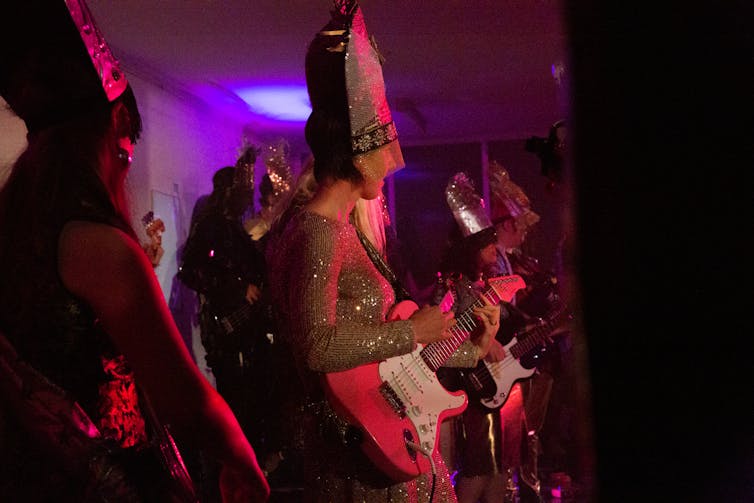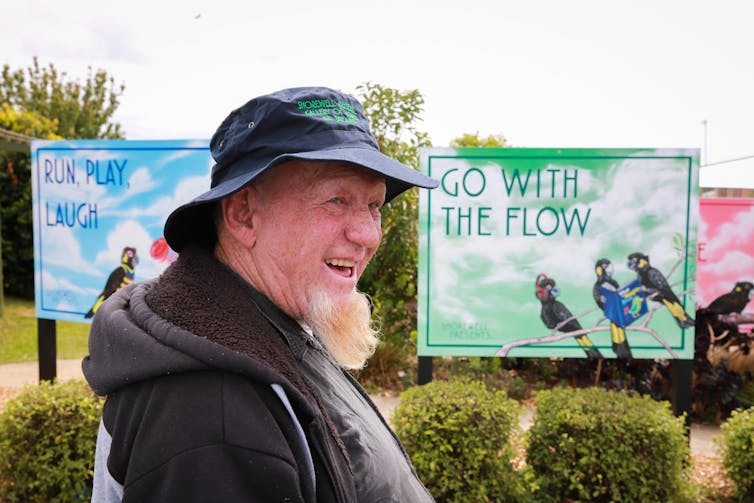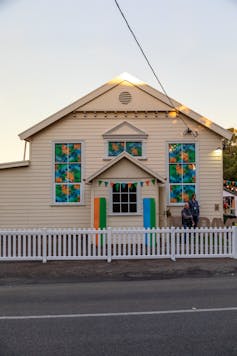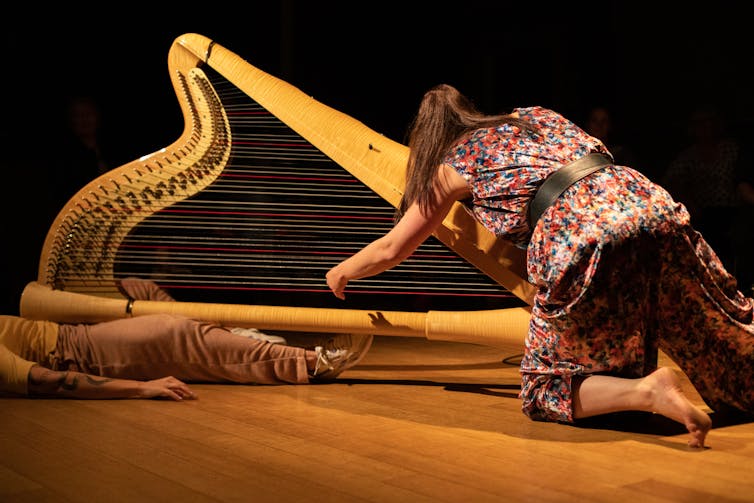Ten Days on the Island: blistering rock, raw urgency, tenderness and dagginess in a festival spread too thin
- Written by Asher Warren, Lecturer, University of Tasmania
Since its launch in 2001, the biennial Ten Days On The Island has aimed to be a festival for the whole of Tasmania, bringing in international artists and putting local artists on the world stage.
This year, as in 2019, the festival’s program — and the titular “ten days” — are spread across three weekends. With travel bans and conservative limits on theatre capacities, the program is thinner than usual, making the stretch across the state an even greater challenge.
Artistic director Lindy Hume proposes a Romantic, rather than Gothic Tasmania, placing Jess Bonde’s photographic re-imagining of Caspar David Friedrich’s 1818 oil painting The Wanderer Above a Sea of Fog as the festival’s central image.
Bonde’s singular figure surveying an uninhabited landscape captures both the loneliness of isolation, and the accomplishment of getting on top of the curve.
The individualism of Romanticism, however, glosses over our collective action to hold back this pandemic, and the communities and institutions we have drawn on for support.
The festival itself is one such institution, calling on communities across the state to flesh out the 2021 program with workshops, talks and a range of projects.
Works by community
One of the few works that will travel the whole state is the charming There is No “I” in Island, led by filmmakers Rebecca Thomson and Catherine Pettman. The series of short films animate local experiences of lockdown.
The films explore an eclectic range of visual styles, but all are deeply engaging, drawing us in to the astonishing candour, humour, and down-to-earth dagginess of the respondents.
It meets the generosity of its participants with respect, weaving experiences of isolation into a resonant whole.
MAPATAZI is a glittering, blistering onslaught of rock: an electric guitar orchestra of 21 local women of all skill levels taking over the back room of the Launceston Men’s Workers Club in a joyously shambolic affair with an infectious sense of fun.
 MAPATAZI orchestra of electric guitars is a joyously shambolic affair.
Ten Days on the Island
MAPATAZI orchestra of electric guitars is a joyously shambolic affair.
Ten Days on the Island
In the 2019 festival, Shorewell Presents … in Burnie took the form of a lavish outdoor dinner, a gesture of generosity exclusively for locals: community art projects are not always about public outcomes.
This year, a series of glossy billboards have been erected around Burnie Community House and the adjacent shopping centre as Shorewell Presents… Gallery of Hopes and Dreams. The billboards display phases chosen by consensus — “We have each other”; “Be kind to yourself”; “Go with the flow” — accompanied by cute comic black cockatoos on eye catching pastel backgrounds.
Our guide, local resident Bluey, was part of the group who developed the phrases, and speaks proudly of them. It has clearly been a meaningful project for him.
 There is a disconnect between the framing and the outcomes of the Gallery of Hopes and Dreams.
Ten Days on the Island
There is a disconnect between the framing and the outcomes of the Gallery of Hopes and Dreams.
Ten Days on the Island
But the billboards read like motivational posters: clean and relentlessly optimistic. The phrases don’t communicate hopes or dreams. They focus on the now, describing tactics (“Let’s smile”) for surviving day to day. The dissonance between the framing, the community input and the outcome suggest this project has not quite met its intention.
While Sydney-based Urban Theatre Projects have a long and strong history of community engaged projects, this felt under-resourced and the language of empowerment eerily neo-liberal. But it did, thankfully, highlight the incredible work of Burnie Community House.
 Ten community halls across the state are hosts for the festival.
Sonja Ambrose/Ten Days on the Island
Ten community halls across the state are hosts for the festival.
Sonja Ambrose/Ten Days on the Island
The centrepiece of the festival, If These Halls Could Talk, produced events for ten regional community halls across the state.
Produced in regional New South Wales in 2015, in the original vision, each project told the unique story of each hall. Here, the halls I visit are presenting events, rather than being the focus of the art themselves.
In Rowella, I watch Tasdance’s Where do We Start, a series of short duets between dancers and musicians developed from discussions that began over Zoom. The process has produced a vibrant quintet of performances, full of a raw urgency.
The standout is a collaboration between harpist Emily Sanzaro and dancer Jenni Large, transforming the harp from instrument into a third dancing body moving around the space. The exploratory resonance of voices and strings across the three bodies summons tenderness and strength, encapsulating a sensual and defiant resilience responding to more than just the pandemic.
 In a series of duets between dancer and musician, the harp becomes a third performing body.
Sonja Ambrose/Ten Days on the Island
In a series of duets between dancer and musician, the harp becomes a third performing body.
Sonja Ambrose/Ten Days on the Island
An uncertain recovery
Ten Days is much cherished by Tasmanians, and since the arrival of MONA’s festivals, has served as an important cultural counterpoint. The 2019 festival ambitiously targeted a greater regional focus, and from this, a sense of optimism.
Read more: Births, deaths and rituals: a revamped Ten Days on the Island explores Tasmania's past and present
This year, the festival seems overburdened by the task of reaching the whole island, and spread too thin over the first two weekends.
There was a sense of things coming together at the last minute – from the late announcement of various workshops and talks, to the hand drawn sign on the street in Burnie and the letters lost in the post that were supposed to be part of an otherwise charming wilderness walk in A Weekend Poetical.
While these community works show how the arts might lead our recovery from the pandemic, they also show the lingering aftereffects: this recovery is going to take some time.
Authors: Asher Warren, Lecturer, University of Tasmania



